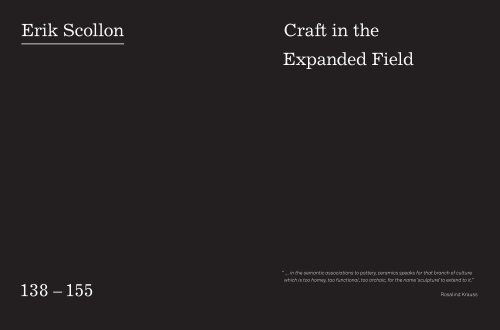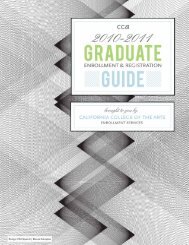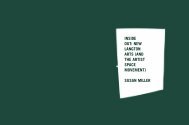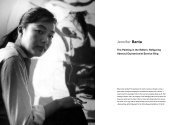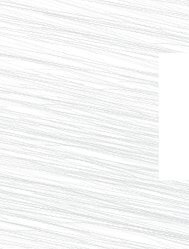Craft in the Expanded Field 138 â 155 Erik Scollon
Craft in the Expanded Field 138 â 155 Erik Scollon
Craft in the Expanded Field 138 â 155 Erik Scollon
- No tags were found...
Create successful ePaper yourself
Turn your PDF publications into a flip-book with our unique Google optimized e-Paper software.
<strong>Erik</strong> <strong>Scollon</strong><strong>Craft</strong> <strong>in</strong> <strong>the</strong><strong>Expanded</strong> <strong>Field</strong><strong>138</strong> – <strong>155</strong>“ … <strong>in</strong> <strong>the</strong> semantic associations to pottery, ceramics speaks for that branch of culturewhich is too homey, too functional, too archaic, for <strong>the</strong> name ‘sculpture’ to extend to it.”Rosal<strong>in</strong>d Krauss
For almost thirty years, art schools havewidely circulated art historian Rosal<strong>in</strong>dKrauss’ “Sculpture <strong>in</strong> <strong>the</strong> <strong>Expanded</strong> <strong>Field</strong>”as a lens through which to understandthree-dimensional art. The tool with whichshe unpacked <strong>the</strong> sculptural practices of<strong>the</strong> 1970s can be useful for understand<strong>in</strong>g<strong>the</strong> various forms of craft prevalentthroughout <strong>the</strong> twentieth century. Today,while <strong>the</strong> term “craft” is widely used, itsexact significance rema<strong>in</strong>s ambiguous.Of <strong>the</strong> many ways it is used <strong>in</strong> <strong>the</strong> contextof art, almost all of <strong>the</strong>m rely on materialidentification: ceramic, glass, fiber, wood,or f<strong>in</strong>e metal. As a start<strong>in</strong>g po<strong>in</strong>t, we willfocus on one material, ceramic, to teaseout a logical way to describe four differenttypes of ceramic practice. Once wecan see that craft and sculpture are justtwo po<strong>in</strong>ts with<strong>in</strong> <strong>the</strong> field of ceramics,we can better describe <strong>the</strong>ir relationshipand make comparisons with o<strong>the</strong>r formsof material exploration.Krauss based her schema upon twomaterial identifiers: landscape and architecture.I’ll take a broader approach and<strong>in</strong>stead use <strong>the</strong> descriptors functional andmimetic as a way of sketch<strong>in</strong>g out a differentlyexpanded field. This will allow for amore flexible methodological tool that canbe applied to o<strong>the</strong>r craft materials, as wellas to o<strong>the</strong>r forms of artistic practice.Start<strong>in</strong>g Po<strong>in</strong>t: Sculpture <strong>in</strong> <strong>the</strong><strong>Expanded</strong> <strong>Field</strong>In 1979 Rosal<strong>in</strong>d Krauss noted a pluralism<strong>in</strong> <strong>the</strong> term “sculpture,” which, as she put it,141
had been “kneaded, stretched, and twisted”by writers and critics so that it couldcover newly emerg<strong>in</strong>g three-dimensionalart forms. 1 Earthworks, quasi-architecturalstructures, and o<strong>the</strong>r comb<strong>in</strong>ations of architectureand landscape were designated“sculpture” as a way to make us feel as ifwe were experienc<strong>in</strong>g work that fit <strong>in</strong>to ahistorical l<strong>in</strong>eage. By categoriz<strong>in</strong>g <strong>the</strong>seobjects as sculpture, she wrote, “<strong>the</strong> new[was] made comfortable by be<strong>in</strong>g madefamiliar, s<strong>in</strong>ce it [was] seen as hav<strong>in</strong>g graduallyevolved from <strong>the</strong> forms of <strong>the</strong> past.” 2Krauss identified this familiariz<strong>in</strong>g moveas historicist, and expla<strong>in</strong>ed: “Historicismworks on <strong>the</strong> new and <strong>the</strong> different to dim<strong>in</strong>ishnewness and mitigate difference.” 3L<strong>in</strong>k<strong>in</strong>g toge<strong>the</strong>r such wildly differentworks of art as Robert Smithson’s SpiralJetty and Bern<strong>in</strong>i’s statue The Conversionof Constant<strong>in</strong>e was confus<strong>in</strong>g because<strong>the</strong>ir respective artistic propositions hadvery little <strong>in</strong> common. “Sculpture,” Krausswrote, had been “forced to cover such aheterogeneity that it [was], itself, <strong>in</strong> dangerof collaps<strong>in</strong>g.” 4In <strong>the</strong> 1970s, artists had been rework<strong>in</strong>g<strong>the</strong> ideas of landscape and architectureboth with<strong>in</strong> <strong>the</strong> gallery and outside it. Inei<strong>the</strong>r context, <strong>in</strong> order to be regardedas sculpture, this work needed to be def<strong>in</strong>edas be<strong>in</strong>g nei<strong>the</strong>r <strong>the</strong> landscape norarchitecture as such. This is what madeit possible to differentiate an earthworkfrom a garden, and apparently functionlessstructures from “<strong>the</strong> real space of architecture.”5 Krauss noted that sculpture wasbeg<strong>in</strong>n<strong>in</strong>g to be recognized only througha condition of ontological absence: “That[which] is <strong>in</strong> <strong>the</strong> room [but] is not really <strong>the</strong>room” and that which is <strong>in</strong> <strong>the</strong> landscape,but is “not <strong>in</strong> fact part of <strong>the</strong> landscape.” 6Sculpture came to occupy <strong>the</strong> neuteredposition, to be understood only through<strong>the</strong> “comb<strong>in</strong>ation of exclusions.” 7 As a result,too many th<strong>in</strong>gs were be<strong>in</strong>g classifiedunder <strong>the</strong> same label.If sculpture had been reduced to acomb<strong>in</strong>ation of exclusions that did notadequately describe <strong>the</strong> complexity of currentart practices, Krauss realized that aprojection of <strong>the</strong> positive comb<strong>in</strong>ation oflandscape plus architecture could providea more subtle understand<strong>in</strong>g. The projectionshe used is called a Kle<strong>in</strong> group, amapp<strong>in</strong>g structure borrowed from ma<strong>the</strong>maticsand 1960s structuralism thatmakes it possible to go beyond <strong>the</strong> neuteror <strong>the</strong> negative, <strong>in</strong>to <strong>the</strong> complex or <strong>the</strong>positive. It also makes it possible to th<strong>in</strong>k<strong>in</strong> o<strong>the</strong>r comb<strong>in</strong>ations of both positiveand negative. While mirror<strong>in</strong>g <strong>the</strong> orig<strong>in</strong>alopposition, this diagram also opens it upwithout alter<strong>in</strong>g it.Under this schema, <strong>the</strong> complex is<strong>the</strong> positive comb<strong>in</strong>ation of both landscapeand architecture. Krauss identified<strong>the</strong>se as “site constructions.” She labeledfur<strong>the</strong>r comb<strong>in</strong>ations of <strong>the</strong>se poles, suchas architecture+not-architecture, as “axiomaticstructures,” and <strong>the</strong> comb<strong>in</strong>ation oflandscape+not-landscape as a “markedsite.” Krauss broke down <strong>the</strong> stretchedand pluralistic term of “sculpture” <strong>in</strong>toa broader array of terms with more preciselyidentified mean<strong>in</strong>gs. This specificitywas useful <strong>in</strong> that it helped differentiateseem<strong>in</strong>gly similar objects that had beenuncomfortably thrown toge<strong>the</strong>r. It also had<strong>the</strong> advantage of avoid<strong>in</strong>g <strong>the</strong> historicizationof new work through an old term.<strong>Craft</strong> <strong>in</strong> <strong>the</strong> <strong>Expanded</strong> <strong>Field</strong>Hav<strong>in</strong>g established Krauss’ work as a start<strong>in</strong>gpo<strong>in</strong>t, I would like to argue that <strong>the</strong>current usage of <strong>the</strong> term “craft” is overextended<strong>in</strong> a similar way. Because craftpractice often <strong>in</strong>volves historical methodsof mak<strong>in</strong>g th<strong>in</strong>gs, <strong>the</strong> temptation to constructa historical l<strong>in</strong>eage for <strong>the</strong> work isstrong. But collect<strong>in</strong>g a diversity of objectsand practices underneath a familiar andall-purpose term runs <strong>the</strong> risk of obscur<strong>in</strong>g<strong>the</strong>ir differences and caus<strong>in</strong>g confusion.The result of this historicism has led towhat can only be called as an identity crisisfor craft. Because of <strong>the</strong> difficulties <strong>in</strong>p<strong>in</strong>n<strong>in</strong>g down its mean<strong>in</strong>g, museums andschools have found it easier and more politicto drop “craft” from <strong>the</strong>ir titles. 8 Onceasked to embrace new forms of expressionthrough material essentialism or an overlybroad historical context, <strong>the</strong> term “craft”has, like sculpture, been stretched “tocover such a heterogeneity that it is, itself,<strong>in</strong> danger of collaps<strong>in</strong>g.” 9A quick newsstand survey of periodicalsdedicated to <strong>the</strong> promotion ofcraft suggests some cohesion and a unifiedstyle revolv<strong>in</strong>g around a select setof materials, whe<strong>the</strong>r woven fabric, f<strong>in</strong>ewoodwork<strong>in</strong>g, jewelry, ceramics, or glass.Once one probes a little deeper <strong>in</strong>to eachpublication, however, a more complex pictureemerges. American <strong>Craft</strong> and <strong>Craft</strong>:The Magaz<strong>in</strong>e for Contemporary <strong>Craft</strong> claimalmost every object made of <strong>the</strong> materialsmentioned above, both functional andsculptural, and discuss <strong>the</strong>m with<strong>in</strong> an artcontext. The <strong>Craft</strong>s Report aims to helpobject makers work<strong>in</strong>g with <strong>the</strong>se materialsmarket <strong>the</strong>ir work and navigate <strong>the</strong>tricky waters of commerce. The new kid on<strong>the</strong> block, <strong>Craft</strong>: Transform<strong>in</strong>g Traditional<strong>Craft</strong>s, is a do-it-yourself smorgasbord ofstep-by-step <strong>in</strong>structions, cover<strong>in</strong>g activitiesas diverse as knitt<strong>in</strong>g iPod cases and142 Sightl<strong>in</strong>es ⁄ <strong>Erik</strong> <strong>Scollon</strong> 143
artists, like Rod<strong>in</strong>, put clay to <strong>the</strong> task ofmimetic representation. Yet, <strong>in</strong> <strong>the</strong> latemodernist era of <strong>the</strong> 1950s, ceramic as achoice of material <strong>in</strong> <strong>the</strong> service of sculpturecame <strong>in</strong>to question. Krauss clearlyarticulated this skepticism when shesaid:to be a ceramicist-sculptor <strong>in</strong> <strong>the</strong>1950s and ’60s was <strong>in</strong> some essentialway to be marg<strong>in</strong>al to “sculpture.” … Itwas that <strong>the</strong> medium itself had craftassociations. And <strong>the</strong>se associationsare <strong>in</strong>tolerable to sculpture … And<strong>in</strong> <strong>the</strong> semantic associations to pottery,ceramics speaks for that branchof culture which is too homey, toofunctional, too archaic, for <strong>the</strong> name“sculpture” to extend to it. 16As she suggests, <strong>the</strong> critical issue wasthat <strong>in</strong> <strong>the</strong> 1950s and ’60s, it was potters,with <strong>the</strong>ir background <strong>in</strong> utility and function,who were putt<strong>in</strong>g clay to expressiveuse, not f<strong>in</strong>e art sculptors, who usuallyexploited clay’s mimetic and representationalqualities.The potter most actively <strong>in</strong>vestigat<strong>in</strong>gthis problem was Peter Voulkos, who foundthat his utilitarian, vessel-based work wasmarg<strong>in</strong>alized <strong>in</strong> <strong>the</strong> galleries and museums<strong>in</strong> New York. In response, he chose to<strong>in</strong>terrogate <strong>the</strong> conventions under whichhis work was excluded. Krauss herself hasnoted that <strong>the</strong> condition of marg<strong>in</strong>ality canbe useful because it makes available <strong>the</strong>problems of assimilation as a fertile groundfrom which to draw <strong>in</strong>spiration. Artistswork<strong>in</strong>g <strong>in</strong> <strong>the</strong> marg<strong>in</strong>s are forced to th<strong>in</strong>kabout <strong>the</strong> conditions of <strong>the</strong>ir exclusion. 17Voulkos responded by toy<strong>in</strong>g with<strong>the</strong>se conditions as he created forms us<strong>in</strong>g<strong>the</strong> potter’s wheel. But he <strong>the</strong>n tore, cut,and punched through <strong>the</strong>m <strong>in</strong> order to reassemble<strong>the</strong> parts. His piece Rock<strong>in</strong>g Pot(1956) is one of his early explorations withthis set of ideas [Figure 1]. While recognizablya vessel, this pot seems to be at warwith itself, with cut holes, added protrusions,and strange rockers where <strong>the</strong> footof <strong>the</strong> vessel would normally be. Voulkosengaged with <strong>the</strong> conventions of <strong>the</strong> vessel—an<strong>in</strong>terior volume and <strong>the</strong> idea ofconta<strong>in</strong>ment—but subverted each as hedrew attention to <strong>the</strong>m. Then he statedunequivocally: “I claim this as a pot.” 18 So<strong>the</strong>n, how should we understand this work?In <strong>the</strong> past, it has been labeled as both“sculpture” and “craft,” but it does not fitcomfortably under ei<strong>the</strong>r term. If, as Krausshas suggested, “Ceramics is too functionalfor <strong>the</strong> name sculpture to extend to it,” wecan understand why Voulkos would chooseto subvert function. But why not go all <strong>the</strong>way? Why start with a form so rooted <strong>in</strong>pottery? Perhaps because he chose to testit aga<strong>in</strong>st one of <strong>the</strong> o<strong>the</strong>r conventions bywhich we recognize someth<strong>in</strong>g as art. Hewas deny<strong>in</strong>g a mimetic or representationalquality to <strong>the</strong> material and its forms.Rock<strong>in</strong>g Pot is a push and pull with twodescriptors: function and mimesis. Morespecifically, it is not-functional, and notmimetic.If Rock<strong>in</strong>g Pot is nei<strong>the</strong>r sculpturenor craft, how <strong>the</strong>n to describe it?Strategically appropriat<strong>in</strong>g Krauss’words, we can call this work an “axiomaticvessel.” Apply<strong>in</strong>g it to Krauss’ descriptionof axiomatic architecture, we might say:“The possibility explored <strong>in</strong> this category isa process of mapp<strong>in</strong>g <strong>the</strong> [<strong>the</strong> given] featuresof <strong>the</strong> [vessel form]—<strong>the</strong> abstractcondition of openness and closure—onto<strong>the</strong> reality of a given space.” 19 In this way,Voulkos’ <strong>in</strong>vestigation and creation of anaxiomatic vessel matches Krauss’ descriptionof axiomatic architecture.The critics Rose Slivka and Garth Clarkhave identified Rock<strong>in</strong>g Pot as an importantmoment of transition <strong>in</strong> <strong>the</strong> pottery/art dialogue. It is also a good po<strong>in</strong>t to beg<strong>in</strong>expand<strong>in</strong>g <strong>the</strong> notion of craft. 20 If we beg<strong>in</strong>with <strong>the</strong> double negative, of not-functionaland not-mimetic, what happens when weproject <strong>the</strong> positive version of those twoideas? Borrow<strong>in</strong>g Krauss’ words, “Onceone is able to th<strong>in</strong>k one’s way <strong>in</strong>to thisexpansion, <strong>the</strong>re are—logically—threeo<strong>the</strong>r categories that one can envision, allof <strong>the</strong>m a condition of <strong>the</strong> field itself, andnone of <strong>the</strong>m assimilable to [<strong>the</strong> orig<strong>in</strong>alterm]. And one has ga<strong>in</strong>ed <strong>the</strong> ‘permission’to th<strong>in</strong>k <strong>the</strong>se o<strong>the</strong>r forms. So our diagramfills <strong>in</strong> as follows:” 21In this field, <strong>the</strong> possible comb<strong>in</strong>ationof not-functional and mimetic might be adifferent way to describe ceramic sculpture.It seems difficult to imag<strong>in</strong>e thatKrauss was dismiss<strong>in</strong>g <strong>the</strong> entirety of representationalwork <strong>in</strong> clay. She must havebeen referr<strong>in</strong>g to someth<strong>in</strong>g else. One coulds<strong>in</strong>gle out <strong>the</strong> work of Robert Arneson asa way to talk about <strong>the</strong> new ideas aboutsculpture out of ceramic that emerged <strong>in</strong><strong>the</strong> 1950s and ’60s. Arneson, like Voulkosbegan as a potter with <strong>the</strong> desire to becomea sculptor. 22Arneson exploited clay’s ability tomimic any shape, and take on any appearance,<strong>in</strong> order to create expressive, albeitfunky, representational sculpture. In hispiece Funk John (1963), he chose to mimican everyday functional object, [Figure 2]which allowed him to foreground <strong>the</strong> nonfunctionalquality of his sculpture. Thepiece resembles a functional object, but<strong>in</strong> no way suggests that it ever could, orwould be used: it is pure mimesis. Giventhat Arneson began as a potter, <strong>the</strong> “problem”of function was an issue that he wasready to <strong>in</strong>vestigate and grapple with, butnot necessarily to avoid entirely. As sculpture,Funk John is <strong>the</strong> comb<strong>in</strong>ation ofnot-function and mimesis. But, becauseit referenced <strong>the</strong> functional and embraced<strong>the</strong> hobbyism of colorful, store-boughtglazes, it could not escape what Krauss146 Sightl<strong>in</strong>es ⁄ <strong>Erik</strong> <strong>Scollon</strong> 147
Figure 2. Robert Arneson ⁄ Funk John ⁄ 1963 ⁄ stoneware ⁄ 35.8˝ tallFigure 3. Ehren Tool ⁄ First Platoon-detail ⁄ 2007 ⁄ Porcela<strong>in</strong> with luster and decals ⁄each 4.5˝ x 3.5˝ x 3.5˝called “<strong>the</strong> semantic associations of pottery.”23 This opened up a rich ve<strong>in</strong> to explorefor ceramics as a self-conceived discipl<strong>in</strong>e,with its roots <strong>in</strong> and semantic associationto function. Soon, Arneson would leave allreferences to function beh<strong>in</strong>d, but fromthat po<strong>in</strong>t on, his work is best describedas sculpture, under <strong>the</strong> descriptors notfunctionaland mimetic.Return<strong>in</strong>g to o<strong>the</strong>r po<strong>in</strong>ts on <strong>the</strong> field,<strong>the</strong> positive comb<strong>in</strong>ation of mimetic andfunctional is, I believe, a more helpful wayto understand craft <strong>in</strong> relation to <strong>the</strong> way<strong>the</strong> term is currently be<strong>in</strong>g used. In fus<strong>in</strong>g<strong>the</strong> mimetic and <strong>the</strong> functional, craftobjects can exist <strong>in</strong> <strong>the</strong> conceptual spaceof art, while rema<strong>in</strong><strong>in</strong>g physical facts of<strong>the</strong> everyday that we can use and <strong>in</strong>teractwith. This refram<strong>in</strong>g of <strong>the</strong> term honors<strong>the</strong> functional history of <strong>the</strong> material, whileacknowledg<strong>in</strong>g <strong>the</strong> new ways <strong>in</strong> which <strong>the</strong>term “craft” is be<strong>in</strong>g applied <strong>in</strong> a contemporaryarts context.As an example of craft, I’d like to lookat <strong>the</strong> work of Ehren Tool, whose practice<strong>in</strong>volves throw<strong>in</strong>g thousands of ceramiccups and giv<strong>in</strong>g <strong>the</strong>m away. Collaged across<strong>the</strong> surfaces of <strong>the</strong>se cups are images ofwar and its troubl<strong>in</strong>g cultural representations,from archival military documents,<strong>the</strong> news media, high art, low culture, enterta<strong>in</strong>ment,fashion, porn, toys, and <strong>the</strong>Internet. By plaster<strong>in</strong>g war-<strong>the</strong>med imageryon objects of everyday use, Tool asksus to exam<strong>in</strong>e and question <strong>the</strong> effects of<strong>the</strong> military on our everyday lives, and howour everyday lives <strong>in</strong> turn affect, or fail toaffect, <strong>the</strong> military mach<strong>in</strong>e. But <strong>the</strong> workis much more than simply representationand imagery. It asserts itself as an objectof utility [Figure 3].Merely view<strong>in</strong>g <strong>the</strong> cup is not enoughfor <strong>the</strong> mean<strong>in</strong>g of <strong>the</strong> work to unfold. Bymak<strong>in</strong>g his work more than just images,and putt<strong>in</strong>g it <strong>in</strong> people’s hands, Tool<strong>in</strong>volves his audience <strong>in</strong> <strong>the</strong> creation ofmean<strong>in</strong>g. Significance unfolds throughuse, over time. The comfortable weightof <strong>the</strong> cup <strong>in</strong> one’s hand, comb<strong>in</strong>ed with<strong>the</strong> knowledge that this precious th<strong>in</strong>gis also breakable, allows it to stand, byanalogy, as a surrogate for human life. Weknow that <strong>in</strong> war time, people can ei<strong>the</strong>rbe cared for and vibrant, or used up andshattered beyond repair. To dr<strong>in</strong>k out of oneof <strong>the</strong>se cups creates a susta<strong>in</strong>ed and <strong>in</strong>timaterelationship, <strong>in</strong> which one becomessomehow responsible for <strong>the</strong> cup, <strong>in</strong> contradist<strong>in</strong>ctionto <strong>the</strong> images of war we seethrough <strong>the</strong> media, which are disposed ofas “old news” almost as quickly as <strong>the</strong>y areproduced and consumed. As craft, Tool’swork embraces function as a conceptuallyimportant way to produce mean<strong>in</strong>g. Itderives its conceptual force from <strong>the</strong> factthat it is a both a dr<strong>in</strong>k<strong>in</strong>g vessel <strong>in</strong> yourhand, and a representation of powers beyondyour grasp.Lastly, <strong>in</strong> ceramics, <strong>the</strong> comb<strong>in</strong>ationof functional and non-mimetic would goby <strong>the</strong> obvious name, pottery, as it <strong>in</strong>corporatesboth utility and non-mimetic, “real”objectness. This is <strong>the</strong> opposite of functionlessand mimetic sculpture. A teapotmay <strong>in</strong>spire o<strong>the</strong>r associations, but it isabove all a real object, or non-mimetic, if it148 Sightl<strong>in</strong>es ⁄ <strong>Erik</strong> <strong>Scollon</strong> 149
is possible to conceive of actually us<strong>in</strong>g it.To understand this, we can <strong>in</strong>voke <strong>the</strong>work of almost any functional potter work<strong>in</strong>gtoday. To consider <strong>the</strong>ir work with<strong>in</strong> <strong>the</strong>expanded field is to comb<strong>in</strong>e <strong>the</strong> functionaland <strong>the</strong> non-mimetic. If one needed to returnto art discourse, it would be possibleto apply a language of “4D formalism” toobjects of everyday use. Functional potscan produce mean<strong>in</strong>g by play<strong>in</strong>g on colorand shape and balance as sensed with <strong>the</strong>eyes and hands and lips, through use, overtime. In do<strong>in</strong>g so, pottery, like craft, has <strong>the</strong>potential to carve aes<strong>the</strong>tic experiencesout of everyday situations.These four po<strong>in</strong>ts, expand<strong>in</strong>g <strong>the</strong> fieldof ceramics, demonstrate how <strong>the</strong>re can bemany possibilities with<strong>in</strong> a s<strong>in</strong>gle materialchoice. This field splits open <strong>the</strong> reductivedichotomy of vessel/figure usually employed<strong>in</strong> ceramic conversations, and itarticulates a more nuanced version of vesselpractices. Just as Krauss noted that notevery three-dimensional art form can befitted with<strong>in</strong> <strong>the</strong> term “sculpture,” not everyceramic object should exist under <strong>the</strong> term“craft.” If we cont<strong>in</strong>ue to call all of <strong>the</strong>seth<strong>in</strong>gs craft, we will always be struggl<strong>in</strong>gto convey our experiences. Each of <strong>the</strong>sepo<strong>in</strong>ts work<strong>in</strong>g <strong>in</strong> different comb<strong>in</strong>ationsof function and mimesis conta<strong>in</strong>s differentviewer/object relationships.To borrow from Krauss:[This] field provides both for anexpanded but f<strong>in</strong>ite set of relatedpositions for a given artist to occupyand explore, and for an organizationof work that is not dictated by <strong>the</strong>conditions of a particular medium.… It is organized <strong>in</strong>stead through auniverse of terms that are felt to be<strong>in</strong> opposition with<strong>in</strong> a cultural situation… any s<strong>in</strong>gle artist might occupy,successively, any one of thosepositions. 24In <strong>the</strong> context I offer here, <strong>the</strong> specificmean<strong>in</strong>g of those words undoubtedlychanges, but we can see how this textlogically describes <strong>the</strong> way that many ceramicistshave often worked. Althoughdedicated to clay, <strong>the</strong>y easily shift betweenpositions with<strong>in</strong> <strong>the</strong>ir field.How <strong>the</strong>n do we relate <strong>the</strong>se examples<strong>in</strong> ceramics to o<strong>the</strong>r forms of material exploration?No doubt glass, textiles, jewelryand wood could be plugged <strong>in</strong>to this grid<strong>in</strong> a similar fashion, us<strong>in</strong>g comb<strong>in</strong>ations offunction and mimesis as analytical tools.For example, <strong>the</strong>re is sculpture carvedout of wood, as well as furniture as a separateand dist<strong>in</strong>ct category. An axiomaticchair might be an object that referenceschairness, but does not actually <strong>in</strong>vite anaudience to sit upon it. With <strong>the</strong>se po<strong>in</strong>ts<strong>in</strong> m<strong>in</strong>d, we can make a more mean<strong>in</strong>gfuland grounded comparison betweenMiriam Schapiro’s patterned fabric assemblagesthat look like quilts and <strong>the</strong> workof <strong>the</strong> women of Gee’s Bend <strong>in</strong> Alabama,who actually made quilts. Schapiro’s workwas treated like pa<strong>in</strong>ted canvas and dest<strong>in</strong>edfor <strong>the</strong> wall, referenc<strong>in</strong>g a quilt thathad lost its function. The quilts from Gee’sBend might seem formally similar, but <strong>the</strong>ywere <strong>in</strong>tended for real beds, and only laterended up on <strong>the</strong> wall. The former could beseen as an axiomatic example, while <strong>the</strong>latter, I would argue, could be comparedto pottery, <strong>in</strong> that both are functional andnot-mimetic. These same considerations,turn<strong>in</strong>g on function and mimesis, could beextended to glass and metals.If we take this field as a set of operationson cultural terms, we can identifymore specific and mean<strong>in</strong>gful relationshipsbetween <strong>the</strong> diversity of objects thatare all too commonly grouped toge<strong>the</strong>r as“<strong>the</strong> craft materials.” This expanded fieldalleviates pluralism, avoids historicism,and more fully explicates <strong>the</strong> differencesbetween sculptural forms and utilitarianobjects while undo<strong>in</strong>g <strong>the</strong> material essentialismthat is usually assumed of <strong>the</strong>sepractices.A Flexible Model: Compar<strong>in</strong>g <strong>Craft</strong> andSocial PracticeAno<strong>the</strong>r pluralism of practice, variouslydescribed as relational form, relationalaes<strong>the</strong>tics, social practice or socialsculpture, shares an aff<strong>in</strong>ity with “craft”practices. The limited space of this essaycannot do justice to all <strong>the</strong> nuances ofrelational form. But, start<strong>in</strong>g with <strong>the</strong>observation that both modes of work<strong>in</strong>ghave suffered from <strong>the</strong> question “Is thisart?” and that that question seems mostdifficult to avoid when utilitarian functionis very obvious <strong>in</strong> <strong>the</strong> work, we canuse <strong>the</strong> same schematic, with <strong>the</strong> sameterms, function and mimesis, as a way toexplore <strong>the</strong> similarities between craft andsocial practices. Only a few examples willbe exam<strong>in</strong>ed here, but <strong>the</strong>y will also helpto unravel some of <strong>the</strong> differences of practicesand actions that are usually lumpedtoge<strong>the</strong>r under one term.I’d like to beg<strong>in</strong> by compar<strong>in</strong>g and contrast<strong>in</strong>gtwo seem<strong>in</strong>gly similar projects,both deal<strong>in</strong>g with food, <strong>the</strong> gallery as asite, and audience <strong>in</strong>teraction. The firstis Rirkrit Tiravanija’s project Untitled (PadThai), which he performed <strong>in</strong> numerousiterations throughout <strong>the</strong> 1990s. Ra<strong>the</strong>rthan present<strong>in</strong>g a collection of objects tobe viewed, he <strong>in</strong>stead destabilized our expectationsof an art open<strong>in</strong>g by cook<strong>in</strong>gThai curry and serv<strong>in</strong>g it to gallery visitors.In do<strong>in</strong>g so, he took <strong>the</strong> social act of cook<strong>in</strong>gand <strong>the</strong> social act of eat<strong>in</strong>g and claimed“<strong>the</strong> social” as <strong>the</strong> form he chose to sculpt.Like Voulkos’ Rock<strong>in</strong>g Pot, this work is bestunderstood under <strong>the</strong> labels not-functionand not-mimesis. Although Tiravanija wasprovid<strong>in</strong>g food to gallery visitors, arguablya functional service, <strong>the</strong> likelihoodof any of <strong>the</strong> art crowd actually need<strong>in</strong>g<strong>the</strong> meal was slim, and <strong>in</strong> this sense, itsfunctionality was not stable. Or, to speak of150 Sightl<strong>in</strong>es ⁄ <strong>Erik</strong> <strong>Scollon</strong> 151
<strong>the</strong> created sociability of <strong>the</strong> visitors, onecould argue that <strong>the</strong> event merely allowed<strong>the</strong> gallerists, artists, and curators of <strong>the</strong>art world to pursue <strong>the</strong> conversations <strong>the</strong>ywould o<strong>the</strong>rwise have had at any art open<strong>in</strong>g.The radicality of Tiravanija’s work hasmore to do with <strong>the</strong> form that it takes, not<strong>the</strong> services it provides. Arguably, it takessometh<strong>in</strong>g that was once functional andturns it <strong>in</strong>to not-function. Moreover, <strong>the</strong>viewer, or audience, is not encouraged toread any part of <strong>the</strong> food or <strong>the</strong> conversationas representational, which <strong>the</strong>reforemakes it not-mimetic.Compare this to Jens Haan<strong>in</strong>g’s SuperDiscount (1998), exhibited at FRI-ART <strong>in</strong>Fribourg, Switzerland. In this work,a shop was established <strong>in</strong> <strong>the</strong> exhibitionspace, which offered salami …biscuits, canned food, pasta, cheese,… cakes, and sweets. The goods werepurchased <strong>in</strong> France [and] importedto Switzerland, [where <strong>the</strong>y wouldbe sold as art objects. This allowedHaan<strong>in</strong>g to take advantage of <strong>the</strong> differ<strong>in</strong>gtax rates levied on <strong>the</strong> sale offood and <strong>the</strong> sale of art.]. This made itpossible for <strong>the</strong> visitors of <strong>the</strong> exhibitionto shop 35 percent cheaper than<strong>in</strong> Swiss supermarkets. 25In terms of use value, this is a morestable and quantifiable functional serviceto <strong>the</strong> visitors. But this work plays with <strong>the</strong>idea that we must view those th<strong>in</strong>gs be<strong>in</strong>gsold as art objects, or asks us to read <strong>the</strong>mas representational of someth<strong>in</strong>g o<strong>the</strong>rthan <strong>the</strong>mselves. O<strong>the</strong>rwise it would be illegalfor <strong>the</strong>m to be sold at that price. SuperDiscount plays with <strong>the</strong> mimetic quality of<strong>the</strong> work. Like craft, Super Discount andworks like it <strong>in</strong> <strong>the</strong> realm of relational form,turn on <strong>the</strong> comb<strong>in</strong>ation of function andmimetic representation.The last comparison I want to makeis between an earlier work, often identifiedas Social Sculpture, and a newer workbetter identified as Social Practice. I’ll useYoko Ono’s Cut Piece (1964) and MichaelSwa<strong>in</strong>e’s recent project, Sew<strong>in</strong>g for <strong>the</strong>People. Both employ cloth<strong>in</strong>g as a material<strong>in</strong> order to problematize and “sculpt”a social relationship. Their methods andcommentary clearly differ, but I would liketo highlight <strong>the</strong>ir structure through <strong>the</strong> useof this field as an analytic device.In Cut Piece, Ono <strong>in</strong>vited her audienceto come onstage and cut away her cloth<strong>in</strong>gwith scissors. In a sense, she sculpted <strong>the</strong>audience and <strong>the</strong>ir reactions, by implicat<strong>in</strong>g<strong>the</strong> social responsibility of <strong>the</strong> viewer/spectator <strong>in</strong> relation to <strong>the</strong> work of art.What I want to emphasize is <strong>the</strong> way <strong>the</strong>work is <strong>in</strong>terpreted. First, we understandit as representational, or mimetic. The actof cutt<strong>in</strong>g her cloth<strong>in</strong>g makes <strong>the</strong> audienceaware of <strong>the</strong>ir relationship to <strong>the</strong> artworkand <strong>the</strong> artist, but we also assign mean<strong>in</strong>gto <strong>the</strong> act, or read it representationally.Second, we can’t see this as functional ei<strong>the</strong>r.This is not employed as a logical wayto get one’s cloth<strong>in</strong>g off. This work dependson mimesis and <strong>the</strong> not-functional <strong>in</strong> orderto generate mean<strong>in</strong>g. In <strong>the</strong> absence of ei<strong>the</strong>rnotion, <strong>the</strong>se same actions could betransformed from a social commentary,<strong>in</strong>to an act that could possibly be illegalor threaten<strong>in</strong>g. In dual dist<strong>in</strong>ction of mimeticand not-functional, it behaves likea form of “sculpture,” which supports <strong>the</strong>fact that this k<strong>in</strong>d of work has often beencalled Social Sculpture.Compare Cut Piece with MichaelSwa<strong>in</strong>e’s piece Sew<strong>in</strong>g for <strong>the</strong> People.S<strong>in</strong>ce 2005, on select afternoons, he haspushed a foot-powered sew<strong>in</strong>g mach<strong>in</strong>e onwheels and set up shop <strong>in</strong> Cohen Alley <strong>in</strong>San Francisco. While <strong>the</strong>re, he mends, freeof charge, any article of cloth<strong>in</strong>g that anyonemay br<strong>in</strong>g to him. Passersby <strong>in</strong>teract, anddiscussion <strong>in</strong>variably ensues. Although <strong>the</strong>work is grounded <strong>in</strong> <strong>the</strong> form of mend<strong>in</strong>g, <strong>the</strong>physical process of repair acts as <strong>the</strong> supportfor <strong>the</strong> actual form, which is <strong>the</strong> social<strong>in</strong>teraction. What I would like to emphasizeis that this work depends upon be<strong>in</strong>g bothfunctional and real. If <strong>the</strong> mend<strong>in</strong>g were notfunctional, <strong>the</strong>n <strong>the</strong> sociability producedwould be radically different. We are not encouragedto read ei<strong>the</strong>r <strong>the</strong> mend<strong>in</strong>g or <strong>the</strong>result<strong>in</strong>g conversation as representational.This comb<strong>in</strong>ation of functional and not-mimeticputs work of this type <strong>in</strong>to <strong>the</strong> samespace as “pottery” <strong>in</strong> our previous field.This expanded field of social practice,which shares <strong>the</strong> same def<strong>in</strong><strong>in</strong>g terms as<strong>the</strong> expanded field of craft, highlights howartists practic<strong>in</strong>g <strong>in</strong> each can be seen toshare a sensibility, and work with<strong>in</strong> <strong>the</strong>same aes<strong>the</strong>tic space. There are <strong>in</strong>stanceswhere <strong>the</strong> work of craft makers could makesense <strong>in</strong> ei<strong>the</strong>r field, depend<strong>in</strong>g on whe<strong>the</strong>rone takes as a po<strong>in</strong>t of departure <strong>the</strong> objector <strong>the</strong> social action. Ehren Tool’s work is anexample that easily bridges <strong>the</strong> two.In clos<strong>in</strong>g, I’d like to once aga<strong>in</strong> callupon Krauss to support my mean<strong>in</strong>g bysay<strong>in</strong>g that this expansionoccurs at a specific moment <strong>in</strong> <strong>the</strong>recent history of art. It seems to meto be extremely important to map[those] structures, and that is whatI have begun to do here. But clearly,s<strong>in</strong>ce this is a matter of history, it isalso important to explore a deeper setof questions which perta<strong>in</strong> to someth<strong>in</strong>gmore than mapp<strong>in</strong>g and <strong>in</strong>volve<strong>in</strong>stead <strong>the</strong> problem of explanation. 26I can sense a shift <strong>in</strong> <strong>the</strong> way that makerscreate and relate to <strong>the</strong>ir objects, whichis at this moment f<strong>in</strong>d<strong>in</strong>g wider supportfrom audiences and critics. Certa<strong>in</strong> k<strong>in</strong>dsof object-mak<strong>in</strong>g have suffered from <strong>the</strong>question “Is this art?” Once we move beyondthat, by position<strong>in</strong>g a work with<strong>in</strong> <strong>the</strong>expanded field, we can address more profoundquestions, such as: What do peopleexpect from <strong>the</strong>ir aes<strong>the</strong>tic experiences?What does <strong>the</strong> k<strong>in</strong>d of work we value tell usabout our society and our culture? And aswe beg<strong>in</strong> to note <strong>the</strong> relational and socialnature of crafted objects, we can consider:What are <strong>the</strong> implications of aes<strong>the</strong>ticiz<strong>in</strong>g<strong>the</strong> social or try<strong>in</strong>g to socialize <strong>in</strong> <strong>the</strong>space of aes<strong>the</strong>tics? Answer<strong>in</strong>g this set ofquestions will help us better understandhow and why <strong>the</strong>se ideas can apply to anengag<strong>in</strong>g art practice.152 Sightl<strong>in</strong>es ⁄ <strong>Erik</strong> <strong>Scollon</strong> 153
Notes1 Rosal<strong>in</strong>d Krauss, “Sculpture <strong>in</strong> <strong>the</strong> <strong>Expanded</strong> <strong>Field</strong>,” October, vol. 8. (Spr<strong>in</strong>g,1979): 30.2 Krauss, 30.3 Krauss, 30.4 Krauss, 33.5 Krauss, 41.6 Krauss, 36.7 Krauss, 36.8 Debbie Hagen discusses <strong>the</strong> perceived identity crisis of craft <strong>in</strong> an article <strong>in</strong> ArtBus<strong>in</strong>ess News, 2005. “Identity crisis? Nam<strong>in</strong>g craft museums proves difficult;some embrace <strong>the</strong> word ‘crafts,’ while o<strong>the</strong>rs have dropped it from <strong>the</strong>ir names,”(accessed March 7, 2008); see also Carol K<strong>in</strong>o, “The Art Form That Dares NotSpeak Its Name,” New York Times, March 30, 2005. G8.9 Krauss, 33.10 http://www.bergpublishers.com/JournalsHomepage/TheJournalofModern<strong>Craft</strong>/tabid/3254/Default.aspx (accessed March 8, 2008).11 The New Oxford American Dictionary, Oxford University Press, 2001, s.v. “craft.”12 Larry Sh<strong>in</strong>er, “The Fate of <strong>Craft</strong>,” <strong>in</strong> Neo<strong>Craft</strong>: Modernity and <strong>the</strong> <strong>Craft</strong>s, ed. SandraAlfoldy, NSCAD Press (2007): 34.13 “The new craft movement encourages people to make th<strong>in</strong>gs <strong>the</strong>mselves ra<strong>the</strong>rthan buy what thousands of o<strong>the</strong>rs already own.” Carla S<strong>in</strong>clair, “The <strong>Craft</strong><strong>in</strong>gof <strong>Craft</strong>: Welcome to <strong>the</strong> new magaz<strong>in</strong>e for <strong>the</strong> new craft movement,” <strong>Craft</strong>:Transform<strong>in</strong>g Traditional <strong>Craft</strong>s, vol. 1 (October 2006): 7.14 The New Oxford American Dictionary, Oxford University Press, 2001, s.v. “craft.”15 “<strong>Craft</strong>: refers to <strong>the</strong> products of artistic production or creation,” Dennis Stevens,“Gett<strong>in</strong>g Straight to <strong>the</strong> Po<strong>in</strong>t,” Redef<strong>in</strong><strong>in</strong>g <strong>Craft</strong>, http://redef<strong>in</strong><strong>in</strong>gcraft.dennisstevens.net/?cat=8&submit=GO(accessed March 12, 2008).16 Krauss, “John Mason and Post-Modernist Sculpture: New Experiences, NewWorlds,” Art <strong>in</strong> America, vol. 67, no. 3, (May-June, 1978): 120.17 Krauss, “John Mason … ,” 120.18 Garth Clark, “Subversive Majesty: Peter Voulkos’s ‘Rock<strong>in</strong>g Pot’” American Art, vol.6, no. 4. (Autumn, 1992): 110.19 Krauss, “Sculpture … ,” 41.20 Rose Slivka, The Art of Peter Voulkos, with Karen Tsujimoto. New York : KodanshaInternational, <strong>in</strong> collaboration with <strong>the</strong> Oakland Museum (1995): 14. Clark, 110.21 Krauss, “Sculpture … ,” 38.22 Glenn Adamson, Th<strong>in</strong>k<strong>in</strong>g Through <strong>Craft</strong>, Oxford; New York: Berg, (2007), 143.23 Krauss, “John Mason … ,” 120.24 Krauss, “Sculpture … ,” 42.25 http://www.nicolaiwallner.com/artists/jens/superdiscount.html (accessedJanuary 15, 2008).26 Krauss, “Sculpture … ,” 42–43.154 Sightl<strong>in</strong>es ⁄ <strong>Erik</strong> <strong>Scollon</strong> <strong>155</strong>


